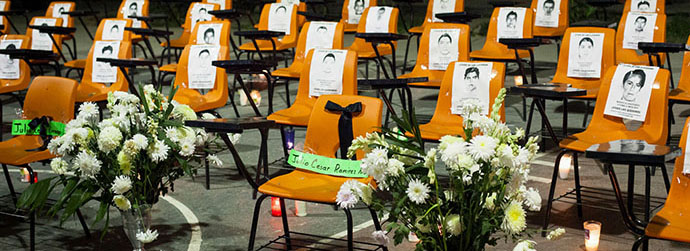The current Mexican government’s crackdowns on narco-trafficking cartels have brought little improvement in the human rights crisis. As the drug war, declared in 2006, enters into its tenth year, murder, enforced disappearances and violent attacks on civil society have become the norm.
The disappearance of the 43 students from the teacher training college at Ayotzinapa in September 2014, which generated worldwide outrage, marked only the tip of the iceberg, as education has become the latest victim of Mexico’s internal conflict.
Schools targeted by drug cartels
An early indication that schools were caught in the firing line of the drug war was an incident which occurred in March 2010 on the Nuevo León campus of the Instituto Tecnológico de Monterrey. Two students were shot at the entrance of their building in a cross-fire between the military and members of a local cartel.
 The incident in Nuevo León quickly triggered a student exodus, with large numbers of young people leaving the region to continue their studies elsewhere in Mexico or across the border in the United States.
The incident in Nuevo León quickly triggered a student exodus, with large numbers of young people leaving the region to continue their studies elsewhere in Mexico or across the border in the United States.
In September 2011 the situation in Mexican schools reached a new low when five severed heads were placed outside the Benito Juarez Primary School in Acapulco. This atrocity was accompanied by handwritten threats against other drug traffickers in the area.
This occurred at a time when teachers across Mexico were being kidnapped and their colleagues and families had received extortion demands asking for large proportions – up to half – of their monthly salaries.
At the time, a high school teacher who wished to remain anonymous stated: “We are all scared […] We are targets because we have a salary that is a bit more stable than the rest.”
 Some 7000 teachers in Acapulco went on strike protesting over security and demanding peace, and 140 schools in the region remained closed for more than a month, severely disrupting teaching timetables.
Some 7000 teachers in Acapulco went on strike protesting over security and demanding peace, and 140 schools in the region remained closed for more than a month, severely disrupting teaching timetables.
When schools opened again in Acapulco, some parents refused to let their children attend for fear that the drug gangs would return.
The violence spreads
The current situation is equally alarming. According to the Mexican newspaper Proceso, narcoviolence has again intensified and the school environment in the states of Tamaulipas, Nuevo León and Coahuila is severely threatened by drug cartels.
Extortion, kidnappings and the murders of university students and teachers have led to the temporary closure of several higher education institutions in the early months of 2015, among them the Nuevo Laredo campus of the Universidad Valle de Mexico (UVM), one of the largest private universities in the country. A spokesperson for the university, Sophie Anaya, said: “The campus closed in response to a threat received from a criminal gang that wanted to enter the facilities, and if not, [said] it would retaliate.”
The security concerns in Nuevo Laredo have led to a renewed student exodus, and the permanent closure of the UVM facility in February 2015, according to a CNN report. In a statement the university affirmed: “Due to the serious nature of the threats, which included direct attempts against the lives of members of our community, we took the decision to vacate the premises and close the campus.”
Mexico’s north-eastern territories bordering on the United States are particularly dangerous and have become a hotspot for illicit activities in recent years. The city of Nuevo Laredo, where the university was based, is under control of the notorious Los Zetas cartel, one of the most feared in the country. Proceso reported that for the past two years, the Gulf Cartel and Los Zetas have demanded a monthly sum of 100,000 to 350,000 pesos from universities in exchange for ‘protection’ from violent attacks.
The right to education
For many years, Mexico has been considered one of the most advanced countries in Latin America in terms of educational standards, although there is a vast discrepancy between rural and urban levels.
According to UNICEF, primary education is almost universal and 45 per cent of children finish secondary school. The current reality of fear and terror puts these achievements at risk.
The right to education in Mexico derives from Article 3 of the country’s Constitution. Given the ravaging levels of lawlessness it cannot be guaranteed anymore in several states. The psychological and physical effects of the conflict, reflected in lower exam results and high drop-out rates, imply long-term consequences for human capital.
Dr. Sergio Cadenas, an expert in higher education policy at Mexico’s Center for Research and Teaching in Economics told Latin Correspondent “When closures occur because of threats or extortion, then without a doubt the authorities should be doing more to protect [schools], especially because educational institutions are the primary tool we have to lead young people away from a life of crime.”
In response, the Peña Nieto government has launched a Safe School Programme. This aims to transform schools into nonviolent spaces, and includes such measures as security cameras, panic buttons, shooting simulation trainings for teachers and students, as well as occasional police patrolling.
Recent events in the country’s border states show that such measures are by no means sufficient and that much wider societal change is needed to provide adequate protection for children from conflict and to give them the chance to create a better future for themselves and their country.

